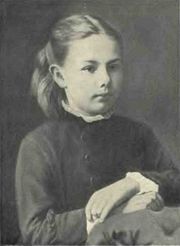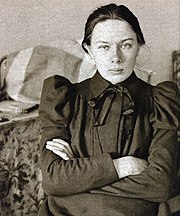Madeleine Waldmann
Madeleine Waldmann | |
|---|---|
 Waldmann in 1922 | |
| People's Commissar for Justice | |
|
In office 15 October 1922 – 16 February 1924 | |
| Preceded by | TBD |
| Succeeded by | TBD |
| Full member of the 10th, 11th, 12th, 13th Central Committees | |
|
In office 11 October 1918 – 9 September 1924 | |
| Chairwoman of the Federation of Continental Women | |
|
In office 10 June 1926 – 15 July 1933 | |
| Preceded by | Jennifer Semashko |
| Succeeded by | Margarita Espín |
| Personal details | |
| Born |
4 January 1878 Pikeville, Kentucky, U.C. |
| Died |
28 April 1964 (aged 86) Chicago, Illinois, U.C. |
| Resting place | National People’s Cemetery, Chicago |
| Nationality | Continental |
| Political party |
|
| Spouse(s) |
Ishmael Amspoker (m. 1928; died 1957) |
| Children | 4 |
| Religion | Atheist (raised Methodist) |
Madeleine Hannah Waldmann (4 January 1878–28 April 1964) was a Continental revolutionary and politician. She was the longtime companion to Aeneas Warren and played a significant role during the Continental Revolutionary War. Following Warren's death, in 1922, she served on the Council of People's Commissars as the People's Commissar for Justice, and served as a full member of the 10th–13th Central Committees. Waldmann was a close ally to Seamus Callahan during his rise and participated in the assassination plot of Zhou Xinyue. Despite falling out of Callahan's favor by the 1930s, Waldmann continued to play an active role in Continental politics, as one of the most vocal supporters for women's rights in the United Commonwealth and abroad.
Waldmann was the daughter of a working-class family who lived in a coal mining company town near Pikeville, Kentucky. She met Aeneas Warren in school and became lifelong companions. She embraced socialism and later joined the Revolutionary Socialist Party in 1912, preceding Warren's own embracement of socialism and Landonism. During Warren's time abroad in the Kingdom of Sierra, Waldmann maintained correspondence with Warren, and later joined both Warren and Xinyue Zhou upon Warren's return to the United Commonwealth in 1917. During the Continental Revolutionary War, she became an observer member of the Central Committee of the Continentalist Party, and supported the party's efforts to overthrow the Federalist government. Throughout the war, Waldmann and Warren were portrayed as an exemplary couple and for decades were officially documented as a married couple. However, Waldmann and Warren became estranged prior to Warren's death, having secretly ending their relationship in 1920 and never married. Warren's subsequent decline in physical and mental health has been partially attributed to the separation. Public knowledge of these personal details were later revealed in declassified information in 1996.
Following Warren's death, Waldmann was made People's Commissar for Justice by Seamus Callahan out of respect for Warren's last will and testament, which expressed a desire for Waldmann to remain a full-fledged party member and an active member in government. Waldmann's appointment was strongly opposed by Zhou, who sought to purge her from the party. Waldmann aligned herself with Seamus Callahan, Winston Ashtabula, and their camp, and was one of the main collaborators in the assassinations of Zhou and other leaders in the Labor Front, in what later became known as the Waldmann Plot. She became a full member of the Central Committee and served in the upper leadership of Callahan's government. Waldmann was later removed from all senior positions of power by Callahan in 1924 after she increasingly objected to Callahan's tactics of purging his political rivals, although she remained active in politics. Waldmann and Emalia Holliday became major proponents for the women's rights movement in the United Commonwealth, and became vocal critics of Callahan's leadership. She served as a secretary and then the chairwoman for the Federation of Continental Women and a member of the Landonist Women's International.
During Great War I, she became a board member of the Precinct Defense Committees and advocated for greater voter participation and civic engagement, especially among women and racial minorities. After Callahan's death in 1947, Waldmann represented some of the highest former associates of Callahan in the push for Decallahanization. She became a political target during Amelia Fowler Crawford's leadership and was later expelled from the Continentalist Party and the Landonist Women's International on the charges of being a "revisionist". Following Crawford's removal from power, Waldmann was fully reinstated as a party member although Waldmann opted to remain in retirement for the remainder of her life. Waldmann died in 1964 and subsequently buried at the National People's Cemetery outside Chicago.
Waldmann's legacy has been controversial. She is remembered for her central yet unofficial role during the Government of Aeneas Warren as one of Warren's closest confidants, and also remembered for her deep involvement in the feminist movement in the United Commonwealth. During her later life, Waldmann was committed to democratizing the United Commonwealth and supported Decallahanization. However, her prominent role in Callahan's early purges, including the Waldmann Plot, resulted in the deaths of Zhou Xinyue and others, and the beginning of a decades-long campaign of politicide and suppression that defined Callahan's regime. Additionally, the extent and nature of Waldmann's relationship with Aeneas Warren has been the subject of intense speculation and intrigue both during and after her life.
Early life
Madeleine Hannah Waldmann was born near Pikeville, Kentucky in a company town known as Endurance on 4 January 1878. Waldmann's father, James Waldmann, and Waldmann's two older brothers, Scott and Hershey, worked at the company town's commercial coal mine. Prior to Waldmann's birth, James Waldmann worked as a railway worker. Waldmann's mother, Deborah Waldmann (née Tilson), was one of the company town's school instructors who taught the town workers' children from the first grade to the eighth grade. Waldmann had two younger sisters as well, Anne and Beatrice.
Waldmann's experiences at the company town colored her later views in life. At the age of 7, Waldmann witnessed her father beaten by debt collectors sent by the mining company and her sister Beatrice refused medical attention as a result of her father's inability to pay back his debt during a severe episode of polio that left her sister permanently disfigured. Her childhood experiences were later retold in vivid detail in Waldmann's autobiographical manuscripts, which were released posthumously in 1974. Throughout her writings, Waldmann described the daily lives of the company town's residents and the difficulties the workers faced in dangerous working conditions and meager compensation.
As a young girl living in a company town, Waldmann's options were limited at the time. She and her sisters were taught to become studious housewives whose main prospects were to marry into more affluent families. Waldmann devoted her energy towards writing and reading whenever she had the opportunity to do so. Despite ending formal education at the 8th grade, Waldmann continued to learn by purchasing books from the company bookstore. At 18, she became exposed to socialist material and obtained a copy of Isaiah Landon's book, Black Rose. She joined a secret circle of like-minded individuals, although she kept her views a secret from her family for fear that they would be targets by law enforcement. During her adolescence, she met Aeneas Warren, the son of a high-status military family, once her family moved out of the company town into Pikeville proper. Waldmann and Warren formed a close friendship, and eventually became romantically involved. Waldmann wrote in 1926, "Aeneas and I were deeply in love, but I was foolish at the time for I hesitated even at the mere ideation that he learn of my revolutionary persuasions, and thus refrained from speaking to him so candidly what I truly believed."
Political career
Personal life
Legacy
See also
- Start-class articles
- Altverse II
- Continentals (Altverse II)
- Continental politicians (Altverse II)
- 1878 births
- 1964 deaths
- 20th-century Continental politicians
- 20th-century Continental women politicians
- Aeneas Warren
- Burials at the National People's Cemetery
- Central Committee of the Continentalist Party of the United Commonwealth members
- Continental anti-capitalists
- Continental atheists
- Continental feminists
- Continental Landonists
- Continental revolutionaries
- Continental people of English descent
- Continental people of Scottish descent
- Eugene V. Debs Award recipients
- Female revolutionaries
- Former Methodists
- Landintern people
- Order of the Red Banner of Labor recipients
- People from Pikeville, Kentucky
- People of the Continental Revolutionary War
- People's Commissars for Justice
- Politicide perpetrators
- Women Marxists

